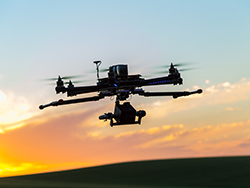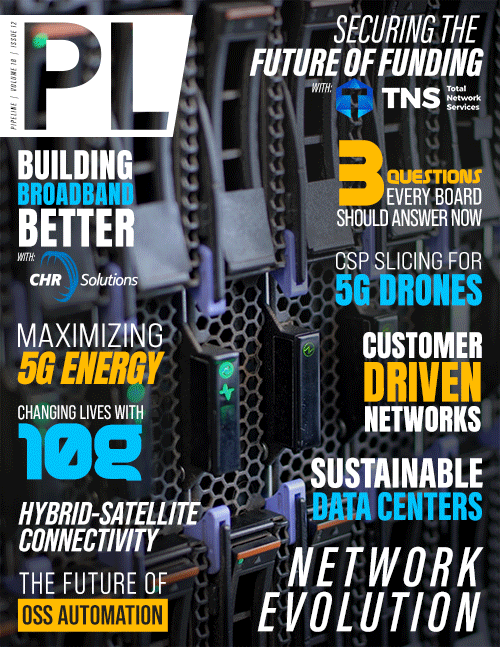How Drones Are Primed for Take-off
with Multi-CSP 5G Slicing
By: Leonard Sheahan

Of all the fundamental advancements enabled by 5G, network slicing may turn out to be the most transformative across a number of industries. By allocating portions of the network to specific industry use cases and guaranteeing low-latency connectivity tailored to their needs, CSPs can go beyond the saturated mobile device market and find new opportunities in potentially mission critical services such as drone connectivity, V2X, cyber-physical control applications, and high-speed rail communications, to name but a few.
Let’s consider one of these examples—drone communications—as an illustrative and representative service that has the potential to be revolutionized with the advent of 5G.
The need for 5G slicing
Mission-critical drone connectivity services of tomorrow will require 5G slicing. Why?
Today, 4G provides a best-efforts network with no QoS guarantees. In addition to the inherent latency of the 4G network, additional latency is introduced using a third-party VPN to isolate the drone traffic streamed over the network. This results in reduced reliability and increased latency of the network connection—both of which render 4G as largely unsuitable for mission-critical drone operations.
From inception, 5G slicing has been designed to provide guaranteed communications at low latency. Applied to our drone scenario, this provides responsive drone control and secures the streamed drone data within the 5G network, avoiding the use of external VPNs. This provides a reliable, low-latency drone communications experience. Furthermore, using APIs to communicate with the CSP, the drone itself can make requests directly of the 5G network, further tailoring the underlying communications experience.
Most drone services today operate using visual line of sight (VLOS). However, regulations are rapidly evolving in many countries permitting remote drone operation using beyond visual line of sight (BVLOS). This increases the importance of highly reliable 5G connectivity and responsive drone control in what promises to be a significant growth market (projected to increase from $8.15 billion in 2022 to $47.38 billion by 2029). With the combination of 5G and slicing, mission-critical drone services can be reliably delivered at scale. Examples include autonomous vehicles requiring reliable and responsive communications, live streaming of events (for example, live sports coverage such as the Tour de France, live news reporting, stadium and track events such as Formula One and more), and surveillance and monitoring of infrastructure (like inspections of towers, pipelines, and powerlines).
The need for multi-CSP coverage
In the future, many mission-critical enterprise services enabled by 5G will require network coverage and capacity that spans beyond the footprint of any single CSP. This will require CSPs to be able to offer mission critical connectivity that spans both their own footprint and that of partner CSPs to provide end-to-end connectivity. This raises the additional problem of how to do this with 5G network slicing, as traditional roaming methods are not yet suitable for many mission-critical services; they just incur too much delay, and customer data needs to be secured, so it cannot traverse a CSP partner’s network.
Putting it into practice – the 5G Flyers Catalyst
At the recent Digital Transformation World event in Copenhagen, this challenge was posed to the 5G Flyers – Phase II Catalyst, which built a showcase of how mission-critical services can be designed and dynamically deployed across multi-CSP networks (using network slicing with an agile and frictionless implementation and operations approach, using the TMF ODA component architecture and Open APIs). Specifically, the goals of the Catalyst were stated in the following manner.
Lester Thomas, Chief IT Systems Architect, Vodafone Global, said, “We challenged the team to illustrate how a representative enterprise service, flying mission-critical drone services, can interact with a CSP using APIs to describe their exact connectivity requirements. These may include the quality, timeframes, and mission coverage which may require additional CSP/NetCo partners. The drone operator should receive a response with precise feasibility, pricing, and an SLA – to order, fly and complete the mission. We also challenged the team to showcase how this can be achieved with an agile and frictionless implementation and operations approach using the TMF ODA component architecture and Open APIs for ‘zero negotiation integration.’”
Herve Bouvier, Project Director with Orange, added, “Many enterprise services enabled by 5G will require network coverage that spans beyond any single CSP footprint as no single CSP can do it all. CSPs will have to partner with other CSPs or NetCos and agree on commercial and technical standards for interoperability to support such services in as dynamic a manner as possible. In this catalyst, we challenged the team to showcase how a CSP can partner with multiple NetCos to deliver such differentiated 5G enabled connectivity services and slices using contemporary IT architectures based on multi-vendor ODA components and Open APIs.”The Catalyst scenario considered a renewable energy company as an enterprise customer that contracts a drone operator for preventative maintenance of its wind turbine and solar panel infrastructure across a large geographic area. The drone operator requests a highly reliable 5G network from the CSP to provide low-latency communications for drone command and control (slice 1) and 4K live streaming video



















